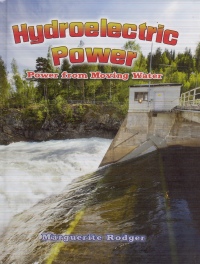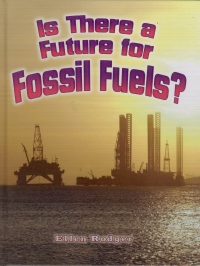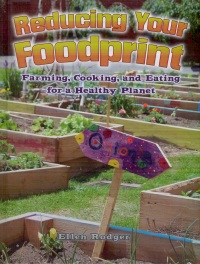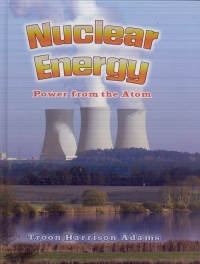| ________________
CM . . .
. Volume XVII Number 5. . . .October 1, 2010 
 |
Hydroelectric Power: Power from Moving Water. (Energy Revolution).
Marguerite Rodger.
St. Catharines, ON: Crabtree, 2010.
32 pp., pbk. & hc., $10.95 (pbk.), $20.76 (RLB.).
ISBN 978-0-7787-2934-1 (pbk.), ISBN 978-0-7787-2920-4 (RLB.).
Subject Heading:
Water power-Juvenile literature.
Grades 4-6 / Ages 9-11.
Review by Daphne Hamilton-Nagorsen.
*** /4
|
| |
|
 |
Is There a Future for Fossil Fuels? (Energy Revolution).
Ellen Rodger.
St. Catharines, ON: Crabtree, 2010.
32 pp., pbk. & hc., $10.95 (pbk.), $20.76 (RLB.).
ISBN 978-0-7787-2937-2 (pbk.), ISBN 978-0-7787-2923-5 (RLB.).
Subject Heading:
Fossil fuels-Juvenile literature.
Grades 4-6 / Ages 9-11.
Review by Daphne Hamilton-Nagorsen.
*** /4
|
| |
|
 |
Reducing Your Foodprint: Farming, Cooking, and Eating for a Healthy Planet. (Energy Revolution).
Ellen Rodger.
St. Catharines, ON: Crabtree, 2010.
32 pp., pbk. & hc., $10.95 (pbk.), $20.76 (RLB.).
ISBN 978-0-7787-2936-5 (pbk.), ISBN 978-0-7787-2922-8 (RLB.).
Subject Headings:
Food-Juvenile literature.
Food industry and trade-Environmental aspects-Juvenile literature.
Sustainable living-Juvenile literature.
Sustainable agriculture-Juvenile literature.
Grades 4-6 / Ages 9-11.
Review by Daphne Hamilton-Nagorsen.
*** /4
|
| |
|
 |
Nuclear Energy: Power from the Atom. (Energy Revolution).
Troon Harrison Adams.
St. Catharines, ON: Crabtree, 2010.
32 pp., pbk. & hc., $10.95 (pbk.), $20.76 (RLB.).
ISBN 978-0-7787-2935-8 (pbk.), ISBN 978-0-7787-2921-1 (RLB.).
Subject Heading:
Nuclear energy-Juvenile literature.
Grades 4-6 / Ages 9-11.
Review by Daphne Hamilton-Nagorsen.
*** /4
|
| |
|

excerpt:
Humans have always wanted more energy than is in their own bodies. Many years ago, horses were harnessed to wagons to make them move. Today, cars move by harnessing the energy found in gas. Fossil fuels, including coal, oil, and gas, power and move many forms of machinery and transportation. In industries, fossil fuels provide energy for chemical changes, and to create synthetic and petrochemical materials such as plastic. It is believed the world demand for energy will almost double by 2050.
These four titles are the most recent in the "Energy Revolution" series which takes elementary-aged readers through various aspects of energy production and use. The series mostly focuses on alternatives to fossil fuels and energy conservation. Each title contains tips for children on how to reduce their energy consumption.
The "Energy Revolution" books are well-written for a younger audience, with shorter sentences and simpler language. Each book has a glossary for the more complex terms. While the language is simpler than for an adult book, the "Energy Revolution" books do not talk down to their audience, a point which readers will appreciate. The layout of the books also recognizes the age of the intended audience. There are many images, most of which have informative captions. In addition to the images, there are information boxes on many pages which provide extra definitions, summaries of important issues or case studies.
Hydroelectric Power provides an overview of hydroelectricity and how it is produced. It gives a very brief overview of the different methods by which electricity can be created from water, including tidal energy. The book moves on to the specifics of hydroelectric power, looking at the history of hydroelectricity, how electricity is created by a hydropower plant, and the pros and cons of this form of electricity creation. Hydroelectric Power briefly looks at the Three Gorges Dam project in China and the future of hydroelectricity. It concludes with a section on reducing energy consumption.
Is There a Future for Fossil Fuels? looks at the history of fossil fuel use and how the use of fossil fuels has expanded. The book moves on to the problems with using fossil fuels, including pollution and the fact that fossil fuel reserves are finite. Is There a Future for Fossil Fuels? concludes with an overview of possible new technologies for alleviating some of the pollution associated with fossil fuels and alternative energy sources.
Reducing your Foodprint looks at the amount of energy that is used for the production and transportation of food and how this could be reduced. The book provides a brief history of agriculture and then moves onto current production methods and the problems with them, such as pesticides and the distance food travels. The book concludes with a look at different ways of reducing your foodprint, such as organic, locally produced and fair-trades foods.
Nuclear Energy takes on the pros and cons of nuclear energy. This book looks briefly at the history of nuclear energy and then moves onto how a nuclear power plant works. The book concludes with a look at nuclear waste and the problems associated with nuclear power plants.
The newest titles in the "Energy Revolution" series provide an informative look at hydroelectric and nuclear energies, fossil fuels and the energy associated with food production and transportation for elementary-aged readers.
Recommended.
Daphne Hamilton-Nagorsen is a graduate of the School of Library, Archival and Information Studies at the University of British Columbia, Vancouver, BC.

To comment
on this title or this review, send mail to cm@umanitoba.ca.
Copyright © the Manitoba Library Association. Reproduction for personal
use is permitted only if this copyright notice is maintained. Any
other reproduction is prohibited without permission.
NEXT REVIEW |
TABLE OF CONTENTS FOR THIS ISSUE
- October 1, 2010.
AUTHORS |
TITLES |
MEDIA REVIEWS |
PROFILES |
BACK ISSUES |
SEARCH |
CMARCHIVE |
HOME |



